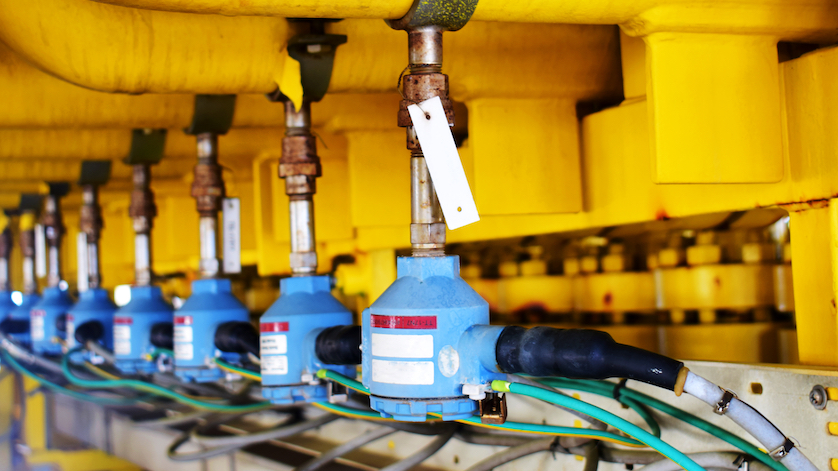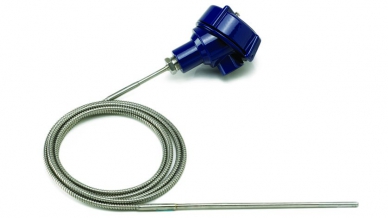
RTDs are widely used in industrial applications. It is important to choose a temperature device with the appropriate material, design, and configuration that meet requirements and comply with the DIN EN 60751 standard for industrial resistance thermometers.
A resistance thermometer – also called an RTD, or resistance temperature detector – uses a sensor whose electrical resistance varies with the temperature. The materials used for the sensors in RTDs have a positive temperature coefficient, which means the electrical resistance of the sensor increases as the temperature rises.
For optimal performance and service life, a resistance thermometer must have the right sensor material, design, and configuration for the particular industrial application. It is also important to compare specifications for accuracy and vibration resistance with the latest DIN EN 60751 standard.
RTD Materials: Pt100 and Pt1000
Unlike thermocouples, which use two dissimilar wires to sense temperature, RTDs have wires made of one metal. Although copper or nickel can be used, the wires in most industrial resistance thermometers today are made of platinum, a metal with very stable resistance over a wide temperature range.
RTDs with a Pt100 sensor have a nominal electrical resistance of 100Ω at 0°C. Those with a Pt1000 sensor have a nominal electrical resistance of 1000Ω at 0°C. Pt100 sensors are cost-effective and the ones most commonly used worldwide. Pt1000 sensors are more expensive, but they have a larger resistance-to-temperature change, which results in better resolution. Other advantages of Pt1000 sensors: They reduce the effect of lead wire resistance and have a longer battery life.
RTD Designs: Wire-Wound vs. Thin-Film
Resistance thermometers can typically be classified as one of two types, either wire-wound or thin-film. In a wire-wound (W) resistor, a thin platinum wire is either fused inside a glass body or spiral-bound inside the cylindrical cavity of a ceramic protective body.
- W glass resistors are highly resistant to vibrations. However, high temperatures change some of the properties of the glass, which, in turn, decrease accuracy. Manufacturing W glass resistors is relatively difficult and expensive.
- W ceramic resistors provide a much broader operating temperature range (–321…+1,112°F, or –196…+600°C) than W glass resistors, but the spiral-bound wire is prone to breakage when subject to high vibrations.
In thin-film (TF) resistors, a fine film of platinum is deposited onto a ceramic plate. The film, plate, and wire connectors are then sealed with a glass layer. TF resistors are very small, resist vibration well, and are very affordable. However, the different materials in each resistor (platinum film, ceramic plate, and glass layer) limit the resistors operating temperature ranges to –58…+932°F (–50…+500°C). Special TF elements have wider temperature ranges but are more expensive.
Pt100 RTDs are an excellent choice for high-vibration applications. However, for processes with especially heavy vibration and very high temperatures, a thermocouple may be a better choice than an RTD.
RTD Configurations: 2-, 3-, and 4- Wire
The 2-wire connection is the most basic configuration. It is also the least accurate, as the internal lead resistance of the wires is added to the measured value. This configuration is not recommended for Pt100 measuring circuits when class AA or class A tolerance is required. But when combined with a PT1000 sensor, a 2-wire configuration becomes more accurate because the sensor’s higher resistance decreases the relative effects of the connecting cables.
In a 3-wire configuration, the third wire is used to assess and compensate for the resistance of the connecting cables. A 4-wire configuration not only eliminates the effects of the connecting cables’ resistance, but also compensates for any asymmetries in the cables. A 4-wire configuration allows the longest cable length with the smallest error rate.

TR15-2 remote mount industrial RTD assembly
RTD Standard: DIN EN 60751
The last update of the DIN EN 60751 standard (in 2009) revised recommendations for platinum resistance thermometers. This standard provides guidelines for several accuracy classes (AA, A, B, C) for both wire-wound and thin-film resistors. These classes are based on the tolerance for the resistance and the measured temperature of RTDs at different operating temperatures, with AA being the most accurate. The standard also provides recommendations for vibration resistance, though they are ambiguous.
WIKA manufactures a broad range of RTDs with platinum resistors that meet or exceed DIN EN 60751:2009 requirements. Our resistance thermometers can be integrated or mounted in a thermowell, or used with direct process connections. Some assemblies, like the TR15-2, can be supplied with a temperature transmitter. Contact WIKA USA for more information about industrial thermometers and how to find the right ones for your applications.


Great post! As someone who works everyday with industrial resistance thermometers, I can safely say you have covered everything needed here to know about the subject